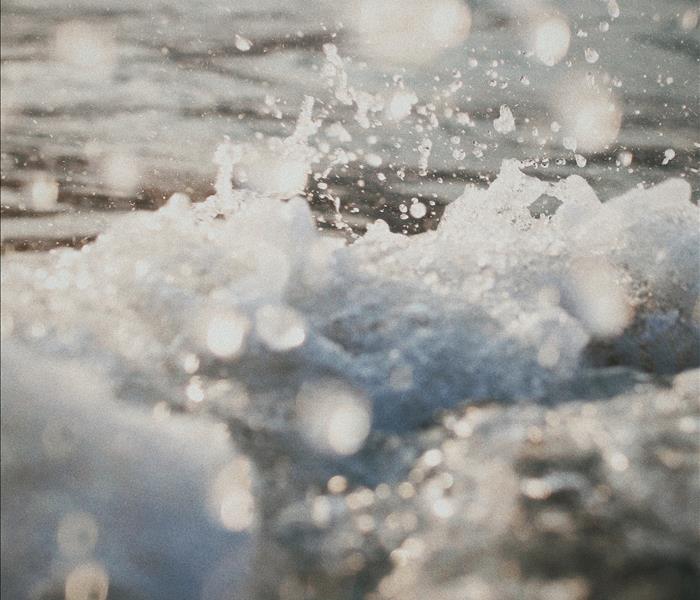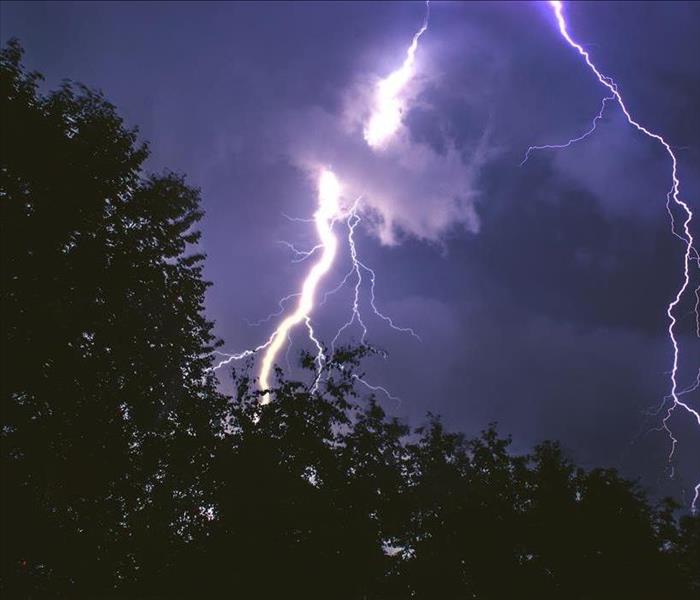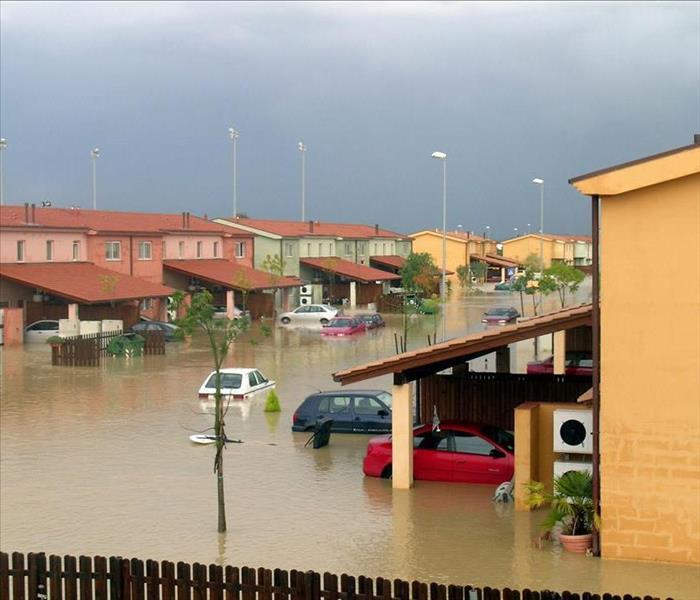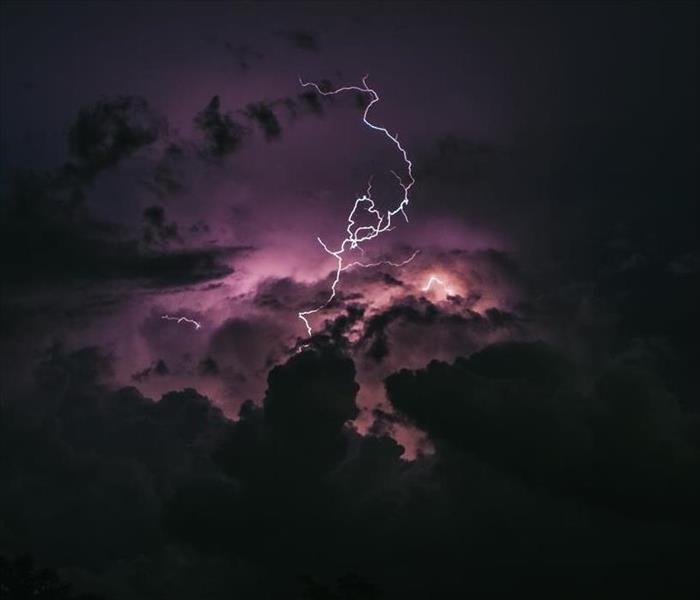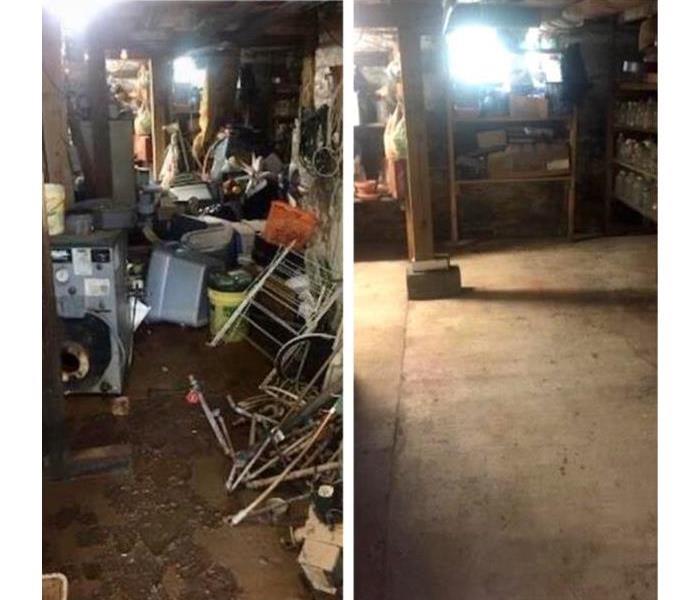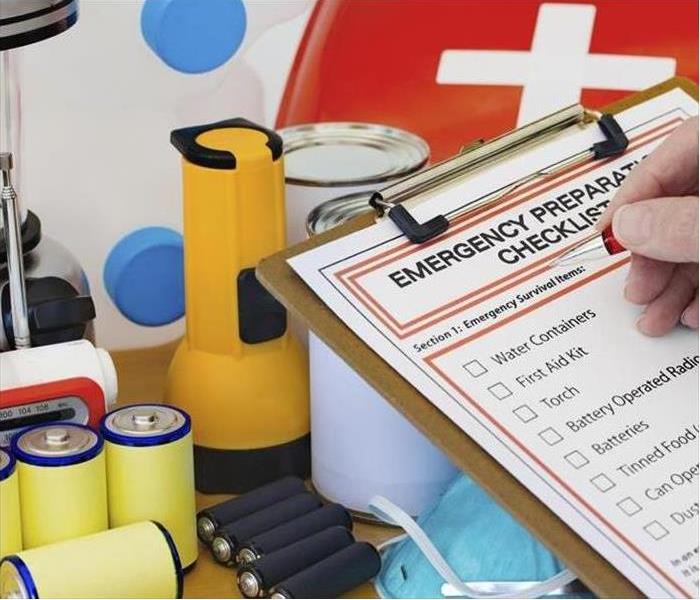Recent Storm Damage Posts
Tropical Storm Ophelia Spares Our Area, But Water Damage Lingers
9/29/2023 (Permalink)
While Tropical Storm Ophelia spared our immediate area from its direct impact, the aftermath brought unexpected challenges for some residents and businesses. At SERVPRO® of College Park, we understand that water damage can occur without warning, and our team remains committed to providing swift and efficient restoration services.
Tropical storms, even when not making landfall directly, can lead to increased rainfall and pose a threat of flooding. Recent incidents in our community have resulted in water damage to both residential and commercial properties. Whether it's a leaky roof, a flooded basement, or any other water-related issue, SERVPRO® of College Park is equipped to handle restoration needs.
Our Expertise:
At SERVPRO®, we pride ourselves on our expertise in water damage restoration. Our skilled professionals are available around the clock to respond to emergencies promptly. We employ advanced techniques and state-of-the-art equipment to assess and mitigate water damage, preventing further issues such as mold growth and structural damage.
Community Commitment:
Our commitment to the community goes beyond responding to emergencies. We understand the stress and disruption water damage can cause, and our goal is to restore normalcy as quickly as possible. SERVPRO® of College Park is dedicated to helping our neighbors through the challenges posed by unexpected water incidents.
Why Choose SERVPRO® of College Park:
- 24/7 Emergency Response: We're always here when you need us.
- Advanced Technology: We use cutting-edge equipment for efficient restoration.
- Highly Trained Professionals: Our team undergoes extensive training to handle various restoration scenarios.
- Local and Trusted: As a part of the community, we take pride in serving our neighbors.
While Tropical Storm Ophelia may not have directly impacted our area, the incidents of water damage emphasize the unpredictable nature of weather-related challenges. SERVPRO® of College Park, Hyattsville and SERVPRO® of District Heights / Landover remains steadfast in its commitment to helping residents and businesses recover from water damage, ensuring that our community stays resilient in the face of unexpected events. If you're dealing with water damage, don't hesitate to reach out to us — we're here to restore your property and peace of mind.
Be Prepared for Summer Storm in College Park, Hyattsville
8/17/2022 (Permalink)
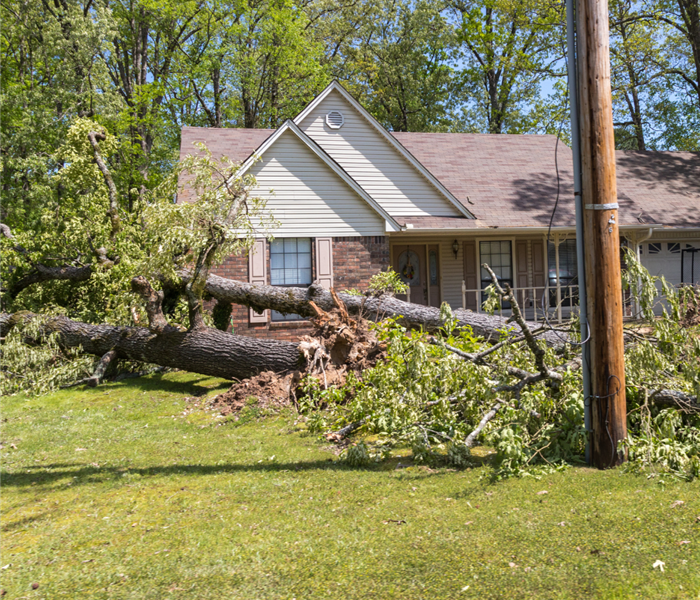 SERVPRO of College Park, Hyattsville certified professionals have the experience and the equipment needed to cleanup and restore your home
SERVPRO of College Park, Hyattsville certified professionals have the experience and the equipment needed to cleanup and restore your home
It is important to be cautious when thunderstorms are in Prince George's County since they are often associated with lightning, flash floods, hail, high winds, and sometimes tornadoes which can all be incredibly dangerous. Read more to learn some helpful tips to follow during a storm.
Preventing Storm Damage
- Trim or remove trees (especially that are dead) that could fall on your home or place of work
- Install surge protectors, lightning rods, or a lightning protection system
- Sign up for your community’s warning system
- Know the risk for thunderstorms in Prince George’s County
During a storm, try practicing these safety precautions:
- Unplug appliances
- Put together an emergency preparedness kit
- Pay attention to alerts and warnings
- If you are playing in the water, get to land immediately and seek shelter
- Pick a safe place in your home for your family to gather during a storm
- Get inside your car and avoid flooded roads. It takes only six inches of moving water to knock you over and only one foot of moving water to sweep away your car
SERVPRO of College Park, Hyattsville and SERVPRO of District Heights/Landover is a full-service restoration and cleanup company. Our certified technicians specialize in mitigation, restoration, cleanup, and construction for both residential and commercial properties. Call us today at 301-779-3662 or 301-577-1166! Our Disaster Recovery Team stands ready to help 24/7.
Storm Safety: Pet Preparedness in College Park, Hyattsville
7/6/2022 (Permalink)
 Our Disaster Recovery Teams stand ready for any size disaster.
Our Disaster Recovery Teams stand ready for any size disaster.
SERVPRO of College Park, Hyattsville and SERVPRO of District Heights / Landover responds 24/7 to your water emergencies. Storms and other disasters can strike at any time of the day or night, so we are ready to help as soon as we are needed. Our team provides many of the services you may need after a storm blows through your area.
Our certified technicians can provide emergency roof tarping and board-up services to help prevent additional damage from the elements and provide security to your property. These services may be needed immediately if your property was damaged by falling trees, hail, high winds, tornado debris, or fire. Read to learn more about pet preparedness and some storm damage tips:
An Evacuation Plan for Your Pets
- Have a buddy system to ensure that someone can take care of your pets or help evacuate your pets if you cannot.
- Make sure to microchip your pet.
- Contact your local emergency management office, animal shelter, or animal control for additional information.
- Build an emergency kit for your pets.
What to Do After a Storm Damage
- Remove excess water by mopping and blotting.
- Wipe excess water from wood furniture after removal of lamps and tabletop items.
- Remove and prop wet upholstery and cushions.
- Place aluminum foil or wood blocks between furniture legs and wet carpeting.
- Turn air conditioning on for maximum drying in summer.
- Remove colored rugs from wet carpeting.
- Remove art objects to a safe, dry place.
- Gather loose items from floors.
Whan a storm disaster occurs, call SERVPRO of College Park, Hyattsville and SERVPRO of District Heights / Landover to handle the mitigation and restoration process in your College Park, Hyattsville, District Heights and Landover property to eliminate mistakes. If you find yourself in need of our expertise or services, call us at 301-779-3662 or 301-577-1166.
SERVPRO of College Park, Hyattsville and SERVPRO of District Heights / Landover
Storm Damage and Your Belongings in Prince George’s
4/28/2022 (Permalink)
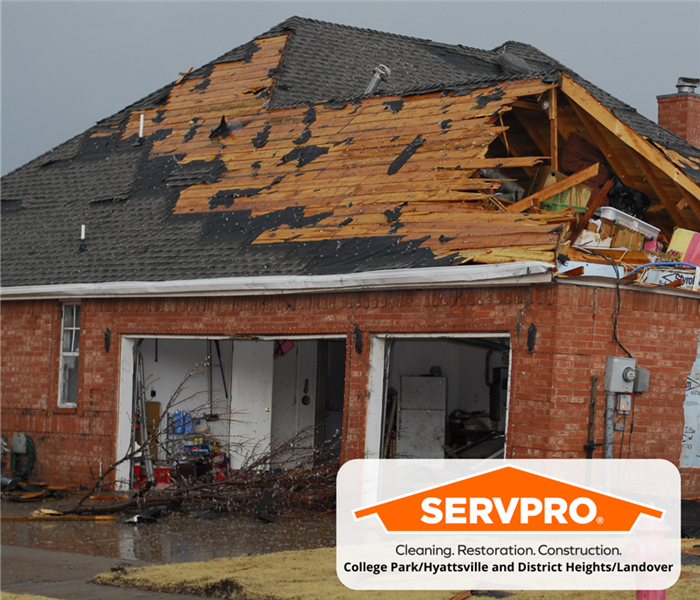 SERVPRO of College Park/Hyattsville and SERVPRO of District Heights/Landover is always Here to Help!
SERVPRO of College Park/Hyattsville and SERVPRO of District Heights/Landover is always Here to Help!
Storm damage does not only affect the structure of your home, business, or commercial property but also your belongings. If your contents are in a water-loss zone, you may need our content manipulation services. Read more to learn about content restoration and move-outs/pack-outs.
Contents Restoration
SERVPRO of College Park/Hyattsville and SERVPRO of District Heights/Landover specialize in restoring contents damaged by storms and other water damage events. Our certified technicians will do their best to restore your contents to save money while preserving precious keepsakes that cannot be replaced. Our technicians will pretest your contents to determine what items can be restored to their condition before the storm damage. The following are several methods we use to clean contents:
- Dry Cleaning – Used for cleaning light residues or to pre-clean before cleaning
- Wet Cleaning – An effective cleaning method for removing moderate to heavy residues
- Spray and Wipe – Effective for items that can’t withstand cleaning
- Foam Cleaning – Used for upholstery fabrics that might shrink or bleed if cleaned
- Abrasive Cleaning – Involves agitation of the surface being cleaned
- Immersion Cleaning – Contents are dipped into a bath of the cleaning products.
Benefits of Move-Outs/Pack-Outs
If your home requires extensive restoration or cleaning, SERVPRO of College Park/Hyattsville and SERVPRO of District Heights/Landover can conduct an organized, efficient move-out of the affected area. Move-out will provide several benefits, including:
- A quicker remodeling process
- Protecting items from potential damage
- Protecting contents from further on-site damage
Call the storm damage restoration professionals, SERVPRO of College Park/Hyattsville and SERVPRO of District Heights/Landover. Our certified professionals are on call to assist homeowners and business owners in a water or fire damage emergency. We dispatch in our office located in Lanham, and that gives us the opportunity to respond quickly to your disaster emergency. We have live SERVPRO representatives to help answer questions and dispatch a crew 24/7 for emergency services. Call SERVPRO of College Park/Hyattsville and SERVPRO of District Heights/Landover at 301-779-3662 or 301-577-1166.
Storm Damage in College Park, Hyattsville, District Heights, & Landover
3/30/2022 (Permalink)
Storms and floods can leave your business or commercial building with extensive water damage. Our certified technicians specialize in repairing and restoring residential & commercial water damage. SERVPRO of College Park/Hyattsville & SERVPRO of District Heights/Landover have more than 45+ years of experience in repair and restoration, so you can trust us to help you develop a restoration plan. Read more about our Emergency READY Profile and how the program can benefit your business.
Preparation is key to making it through any size storm disaster, whether it is a small water leak or an area flood. The best time to plan for such events is not when the event happens, but well before it happens. No one plans on storm damage, but now, you can with the ERP plan.
Emergency READY Profile (ERP)
For business owners, it is crucial to plan for weather disasters to eliminate business interruptions. The SERVPRO Emergency Ready Profile Advantage allows a business owner and staff to know what to do, how to do it, and whom to call so that you are ready for any size disaster emergency. Under this program, a business owner works with a local SERVPRO franchise provider at no cost. This profile document contains only the critical information needed in an emergency. The documents included in the ERP are as follows: emergency contact information, shut-off valve locations, and priority areas.
Having this information on hand helps business owners, staff, and SERVPRO of College Park/Hyattsville & SERVPRO of District Heights/Landover access critical data in a loss. The ERP app provides business owners with access to their ERP information 24/7. The ERP information is now accessible and manageable from your computer, tablet, or Smartphone.
SERVPRO Emergency Ready Profile Advantages:
· No cost assessment of your facility
· A concise Profile Document that contains only critical information needed in the event of an emergency
· A guide to help minimizes the amount of time your business is inactive by having a plan of action
· An identified line of command for authorizing work to begin.
We have the experience and equipment to deal with whatever size of storm damage occurs to your home or business. Our certified technicians will work closely with you during the mitigation, restoration, and construction process. For more information regarding the SERVPRO Emergency READY Profile, call SERVPRO of College Park/Hyattsville & SERVPRO of District Height/Landover at 301-577-1166 or 301-799-3662.
Are You Storm Weather Ready?
12/13/2021 (Permalink)
 When a storm strikes, SERVPRO is the team needed for the job. Our technicians are IICRC certified for any size disaster.
When a storm strikes, SERVPRO is the team needed for the job. Our technicians are IICRC certified for any size disaster.
Are you ready for this upcoming winter season? Colder temperatures can have a huge impact on your Prince George’s County home or business if you do not prepare. Severe winter weather can cause damaging winds, sleet, snow, heavy rain, and freezing temperatures. While you cannot control the weather patterns, you can take steps to prepare for an unfortunate event. To help prevent costly damages due to the weather, consider taking the following precautions to protect your property before colder weather hits.
- Wind, heavy rain, ice, snow can cause branches to fall, which could cause damage to your home or business. Make sure to check your property for debris including, tree limbs and branches.
- Leaves and other debris can lead to roof damage and interior water problems. Ensure to inspect your roof, water pipes, and gutters to avoid structural damage. Gutter downspouts should be directed away from your building.
- To avoid potential flood hazards, inspect your property including, walkways and parking lots.
- To address all slippery and hazardous areas, inspect all handrails, stairwells, and entryways. Install mats or non-slip surfaces and caution signs in hazardous areas.
- When temperatures dip below freezing, protect water pipes from freezing. If pipes are under cabinets, leave the cabinet doors open, allowing warm air to circulate the pipes. If your building has outdoor faucets, shut off the main valve, open the faucet to prevent any remaining water from freezing in the pipe.
Prepare With Our ERP Plan
Ask your local SERVPRO of College Park/Hyattsville and SERVPRO of District Heights/Landover professionals about completing an Emergency READY Profile (ERP). For your business. The ERP is a no-cost assessment of your facility and provides you with a plan to get back in business faster following a disaster. Preparation is key to making it through any size disaster, whether it is a small water leak, a large fire, or storm damage. No one ever plans on a disaster, but now, you can plan and prepare for it with our ERP Plan.
When winter weather strikes, call us at (301)779-3662 or (301)577-1166. Our certified technicians can strike back and help make it “Like it never even happened.”
Severe Storms Around Prince George’s County Can Impact Your Business Operations
11/19/2021 (Permalink)
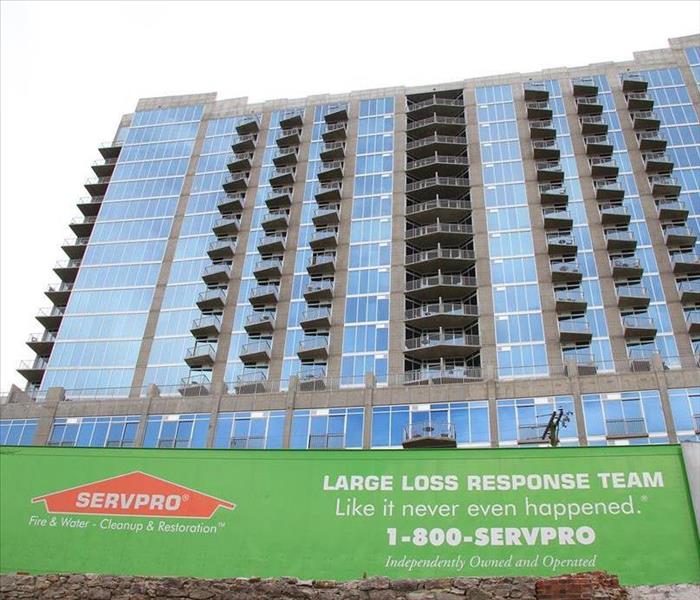 If you have any questions about commercial water damage call, SERVPRO of College Park/Hyattsville and SERVPRO of District Heights/Landover!
If you have any questions about commercial water damage call, SERVPRO of College Park/Hyattsville and SERVPRO of District Heights/Landover!
When storms approach the Prince George’s County region, they can be bad news for your business. Heavy rains and strong winds cause trees and powerlines to fall.
Here are a few tips you can do to minimize any water damages during a storm:
Keep a supply of sandbags.
Protect your files and back up your data.
Store valuable items on high-mounted shelves.
Raise sockets, fuse boxes, and any electrical devices to at least 1.5m above the floor.
Check your roof regularly.
Clear your gutters and pipes and make sure they are free of debris.
If you know a storm is approaching, make sure you have a plan in place. Regardless of the extent of the damage, our highly trained professionals examine each scenario immediately and isolate the damaged area. While we restore your business space, normal operations can continue in a temporary space.
Storm and water damages to businesses are often complex, with numerous issues that require an expert and a quick response. A fast response lessens the damage, limits further damages, and reduces costs. SERVPRO of College Park/Hyattsville and SERVPRO of District Heights/Landover is locally owned and operated. We can restore anything from a small to large commercial storm or water damage emergencies. We exceed your needs both to repair your property and the trust invested in your commercial management.
Why SERVPRO?
Whether it is a business or residence, SERVPRO of College Park/Hyattsville and SERVPRO of District Heights/Landover are equipped to come to your property, and our certified technicians will do a detailed examination of your property damages. We are proud to be part of our community and strive to provide the residents and business owners in our area with the fastest response times. Call us 24/7 at 301- 779-3662 or 301-577-1166.
How To Prepare Your Prince George’s Business For Fall Storms
10/25/2021 (Permalink)
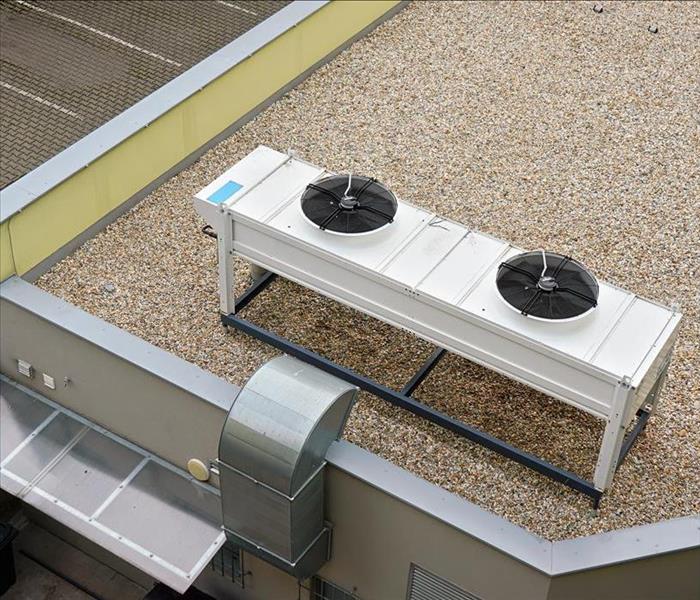 It is essential to prepare your business for the colder months.
It is essential to prepare your business for the colder months.
Know that we are always prepared when you call SERVPRO of College Park/Hyattsville and SERVPRO of District Heights/Landover. If you are expecting storms to hit your Prince George’s location, you need to prepare for any type of harm that may affect your business. There are many risk factors to watch out for, from strong winds to hail damages as you work to prepare your business for the storm. Here are some of the steps you can take to prepare your business for autumn storms.
Inspect Your Roof
It is essential to closely identify any roof problems before attempting to shelter in your home during a storm. Signs to look out for include:
- Cracks and holes
- Loose roof materials
- Debris
- Leaks and discoloration
In severe storm weather, a vulnerable roof can increase your chances of leaks, overflows, and damages to your property’s structure. If your roof is showing signs of damages, make sure to take care of it as soon as possible.
Check Your Commercial HVAC System
Make sure that you give your commercial HVAC system a fall season maintenance. Ensure that the state of the unit and metal panels are properly secured onto the roof to prevent any roof damage from occurring. An HVAC system contractor will ensure that your ac unit will run seamlessly all year round. Having a maintenance schedule in place can assure issues that may surface can be taken care of ahead of time.
SERVPRO of College Park/Hyattsville and SERVPRO of District Heights/Landover are Here to Help!
Post-storm damages are not limited to, but can certainly include water, fire, and even mold damages. If you have experienced any problems, either residential or commercial, SERVPRO of College Park/Hyattsville and SERVPRO of District Heights/Landover will get you back on your feet with a quick response. Call us at 301-779-3662 or 301-577-1166.
Tropical Storm Ida In College Park, Hyattsville, District Heights, and Landover
8/30/2021 (Permalink)
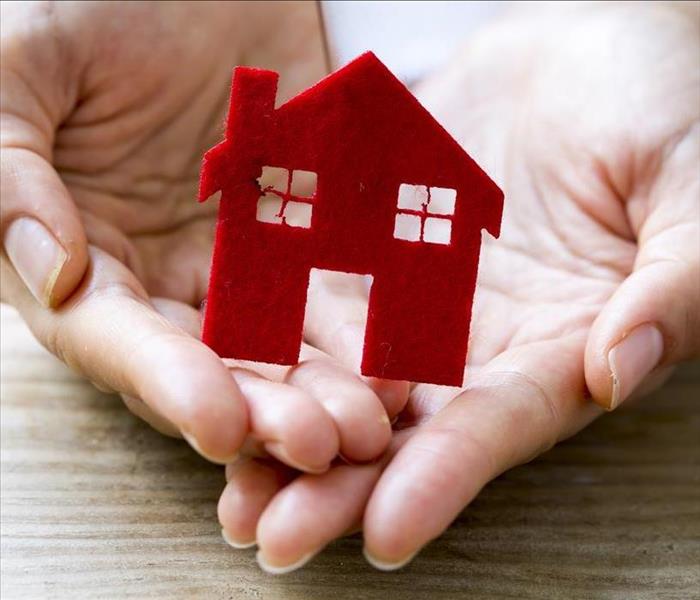 If your property has experienced storm damage call us at 301-779-3662 or 301-577-1166. We will be there “faster to any size disaster!”
If your property has experienced storm damage call us at 301-779-3662 or 301-577-1166. We will be there “faster to any size disaster!”
A few storms ahead, hurricane Ida moves through with a risk of flash floods. According to the National Hurricane Center, there is an increasing risk of dangerous hurricane-force winds, heavy rain, and life-threatening storm surge along the Gulf Coast.
Keep in mind that the path, magnitude, strength, and direction of a storm can change at any time. Flooding, heavy rains, and strong gusts may occur in areas far from the hurricane’s center.
Nearly 90% of all hurricane-related deaths involve water, according to the National Weather Service. The peak of hurricane season for Maryland is between mid-August to late October.
Hurricanes present various hazards, including power outages, rising water levels, high winds, and intense rainfall.
Storm Damage Cleanup and Restoration In Prince George’s
Call SERVPRO of College Park/Hyattsville at 301-779-3662 or SERVPRO of District Heights/Landover at 301-577-1166 if a storm has damaged your home or business.
Our technicians at SERVPRO of College Park/Hyattsville and SERVPRO of District Heights/Landover specialize in cleaning and restoring residential and commercial properties after a fire, water, and storm incident.
Our team is well-versed in property damage repairs. We are storm and water damage specialists who will dry your property back to its pre-storm condition effectively. You can be confident that our staff is prepared to restore your property and make it “Like it never even happened.”
We respond immediately to water and storm damage emergencies. A fast response will lessen the damage, limit further damage, and reduce cost. SERVPRO of College Park/Hyattsville and SERVPRO of District Heights/Landover are available 24 hours a day, seven days a week, and have the training and ability to address any restoration or cleaning emergencies that arise.
SERVPRO of College Park/Hyattsville and SERVPRO of District Heights/Landover 301-779-3662 and 301-577-1166.
Severe Storms Around College Park / Hyattsville / District Heights / Landover Can Cause Power Outages
7/1/2021 (Permalink)
Severe storms can lead to flooding and extended power outages in your entire neighborhood. Being without power can be costly for homeowners and commercial businesses. Don't leave your property to chance when thunderstorms, high winds, and showers hit. Call SERVPRO® of College Park/Hyattsville and SERVPRO® of District Heights/Landover for help. In the meantime, take the following steps to help protect yourself during a power outage.
How Power Outages Impact Us:
- Cause food spoilage and water contamination
- Can disrupt communications, water, and transportation
- Cause closures of grocery stores, gas stations, retail businesses, ATMs, banks, and other services
During A Power Outage:
- Disconnect appliances and electronics to avoid damage from electrical surges
- Keep refrigerators and freezers closed
- If you need to heat your home, do not use a gas stove or oven to heat your home
- If anyone has medical equipment that requires electricity, get them to a place with working electricity or get them to help
- When the lights go off, use a generator, but ONLY outdoors and away from the windows
Water Damage In Your Property
SERVPRO® of College Park/Hyattsville and SERVPRO® of District Heights/Landover specializes in the cleanup and restoration of residential and commercial property after a fire, water, or smoke damage. Our staff are highly trained in property damage restoration, and we are an IICRC Certified Firm.
Quick Response Around College Park / Hyattsville / District Heights / Landover
We respond immediately to your emergency and have the expertise to handle your restoration or cleaning needs.
Give us a call today if you have any questions about water damage and water mitigation. Call SERVPRO® of College Park/Hyattsville and SERVPRO® of District Heights/Landover at 301-779-3662 or 301-577-1166.
SERVPRO® of College Park/Hyattsville and SERVPRO® of District Heights/Landover provide 24-hour emergency service. When fire and water take control of your life, we help you get it back.
Source:https://www.ready.gov/power-outages
Are Your Fur Friends Safe for When A Storm Hits?
5/27/2021 (Permalink)
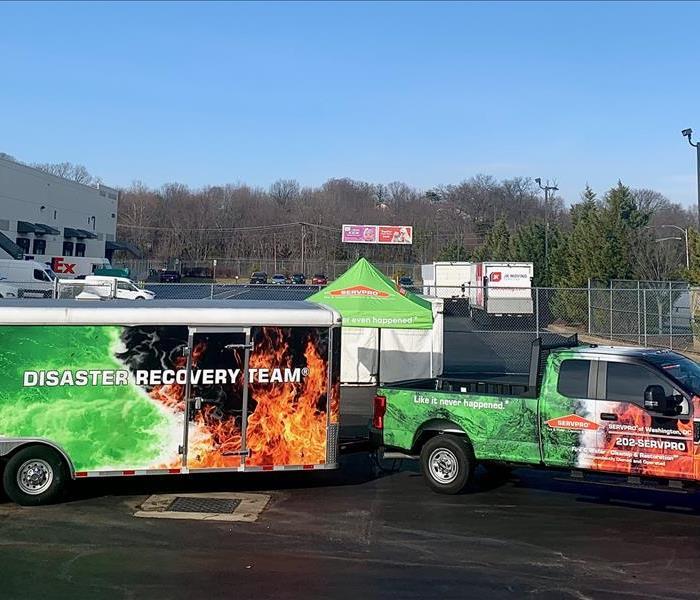 Our SERVPRO® experts will take care of any storm damage and make it “Like it never even happened.”
Our SERVPRO® experts will take care of any storm damage and make it “Like it never even happened.”
Severe Storms in College Park/Hyattsville/District Heights/Landover
Always prepare for the unexpected. To most people, pets are just as important as family members, so include them in your disaster emergency preparedness plan. When a severe storm hits, if local officials ask you to evacuate, this means your fur friend should too.
Prep Before Severe Storms
- Have an evacuation plan for you and your pets.
- Have a buddy system in place to ensure that someone can take care of your pets or help evacuate your pets if you cannot.
- Make sure to microchip your pet.
- To get additional information, contact your local emergency management office, animal shelter or animal control.
- Build an emergency kit for your pets.
What to Include In A Pet Emergency Kit?
- Store several days of pet food supplies and water in appropriate containers.
- Be sure to include your pet’s medicine and medical records.
- Include important paperwork like registration information, adoption papers, and vaccination records. Also, make sure that they are available online.
- Keep a spare leash, collar, and identification tag.
- First aid kit.
- Include familiar treats, blankets, toys, and bedding.
Lastly - Keep Yourself Updated!
- For local alerts and warnings, pay attention to wireless emergency alerts.
- When told to evacuate or shelter at home and listen to local officials.
- To get weather alerts from the National Weather Service, download the FEMA app.
- At the first sign of a severe storm approaching, always bring your pets indoors.
When flooding incidents occur, call SERVPRO® to handle the mitigation and restoration processes in your College Park/Hyattsville/District Heights/Landover property to eliminate mistakes. If you find yourself in need of our expertise or services, visit our website at
SERVPRO® of College Park/Hyattsville and SERVPRO of District Heights/Landover or give us a call at 301-530-7400.
Ready.gov/animals lists the following items as essentials for building a Pet Emergency Kit
Thunderstorms & Lightning Hazard Information
5/12/2021 (Permalink)
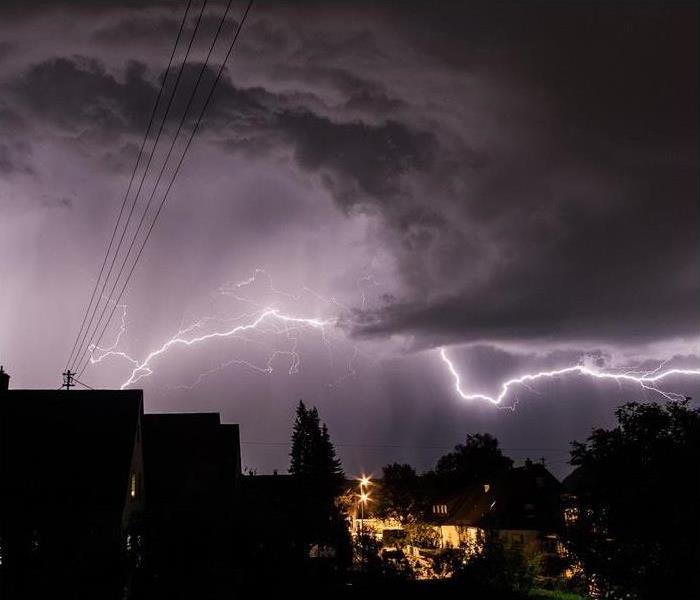 SERVPRO of College Park / Hyattsville and SERVPRO of District Heights / Landover specializes in mitigation and restoration services.
SERVPRO of College Park / Hyattsville and SERVPRO of District Heights / Landover specializes in mitigation and restoration services.
When thunder roars, go indoors! Thunderstorms are dangerous storms that can create hail, cause flash floods and tornadoes. Which often leads to structural roof and mold problems. According to FEMA, no state in the U.S. is 100% safe from severe weather threats. When a thunderstorm threatens the College Park / Hyattsville and District Heights / Landover area, it is important to stay safe.
Here are a few Storm Facts provided by Ready.Gov:
Thunderstorms can produce damaging straight-line winds over 50 MPH.
Storms can create a temporary overflow of water onto dry land.
Thunderstorms can cause outages, disrupt transportation, damage buildings, and create landslides.
At any given time, there are about 2,000 thunderstorms in progress.
Here are a few steps to take to prepare for thunderstorms:
Create an emergency plan
Cut down or trim trees that may be in danger of falling on your home
Sign up for your community’s warning system
Assess your area’s risk for thunderstorms
Prep your first aid kit
Don’t wait until the last minute to prepare for storm and water emergencies. SERVPRO of College Park/ Hyattsville and SERVPRO of District Heights / Landover provides emergency mitigation and restoration services 24 / 7 / 365.
Thunderstorms and water leaks can be very damaging. Water can easily seep into your home and soak into the floors, walls, furniture and other surfaces. SERVPRO of College Park / Hyattsville and SERVPRO of District Heights / Landover respond quickly and immediately begin the water extraction process.
If flood water is not dealt with quickly and correctly, it can cause structural damage to your house. Keep in mind that the longer you wait, the more serious the damage will get.
Call Us Today! SERVPRO of College Park / Hyattsville and SERVPRO of District Heights / Landover
The bottom line: thunderstorms can affect your safety and your home’s integrity. Let our trained professional at SERVPRO of College Park / Hyattsville and SERVPRO of District Heights / Landover handle the situation safely and correctly.
For SERVPRO of College Park / Hyattsville Call: 301-779-3662
For SERVPRO of District Heights / Landover Call: 301-577-1166
Hail Storms 101
3/22/2021 (Permalink)
Hail Storm
Are you scared of storms or do you like them? We all have some level of admiration for hurricanes, regardless of which side we are on. They can cause significant harm, paint beautiful pictures across the sky, disrupt any outdoor plans, and completely change the course of a day. While you've certainly seen a lot of thunderstorms in your life, you may not know much about them. In today's post, we'll share some interesting storm information that you may not have known!
- A typical thunderstorm has a diameter of 15 miles!
- A typical thunderstorm lasts approximately 30 minutes.
- At any given time, approximately 1,800 thunderstorms are occurring around the planet.
- Every year, lightning kills more people than tornadoes.
- A severe storm “watch” indicates that a severe storm has the potential to form but has not yet done so. A severe storm "alert" on the other hand indicates that a storm has formed and been sighted.
- Just about 10% of storms are rated as "extreme."
- If you've heard the phrase "four horsemen" of thunderstorms, it refers to wind/tornadoes, hail, floods, and lightning.
- Thunderstorm clouds can reach heights of more than 20,000 feet!
- A “derecho” is a form of extreme storm that lasts a long time, travels a long distance, and has high winds.
- Even without a tornado, wind speeds in thunderstorms can reach 120 mph.
- In 1984, a major hailstorm in Munich, Germany, caused over $1 billion in damage.
- Large hailstones containing new, frozen ducks were confirmed to have dropped across a city in Massachusetts in 1933.
Can You Stand The Rain? - Storm Safety Tips You Should Know
3/18/2021 (Permalink)
Reading time: 1 min 38 sec
Storms can strike any time anywhere. If a storm struck within the next 15 minutes...would you be prepared? If you answered no, you should keep reading.
Weather incidents account for about 98 percent of all presidentially declared disasters. According to the NOAA, these incidents could result in 500 deaths and nearly $15 billion in damages.
So, how can you ensure that you're as prepared as possible when extreme weather strikes? Recognize the risk and take action. Regardless of how high or low the risk of extreme weather is, it's important to have an emergency plan and supply kit in place just in case.
Items For Emergency Supply Kit
It's important to mix and match these items to suit your specific personal needs, but here are some fundamentals to include:
- Water (1 gallon per person per day)
- Food (non-perishable 3-day supply)
- Manual can opener
- Battery operated radio, preferably and NOAA Weather Radio
- Flashlight and extra batteries
- First aid kit
- Whistle to signal for help, if need be
- Clothing
- Dust masks or bandanas
- Plastic sheeting, garbage bags, and duct tape
- Wrench or pliers to turn off utilities, especially during flood or lightning risks
- Hygiene items
- Important documents; copies of insurance policies, identification, and bank account info
- Cash
- Fire extinguisher
- Matches in a waterproof container
Emergency Ready Profile
While this list is appropriate for a home or organization, if your company requires assistance in developing an emergency plan, let SERVPRO of College Park / Hyattsville and SERVPRO of District Heights / Landover do it for you. We specialize in Emergency Ready Profiles, which help to mitigate disruption and business interruption in the event of an emergency.
Learn More About Emergency Ready Profiles >
We Are Here To Help Every Step Of The Way
When storms hit Prince George’s County, there is always some kind of storm aftermath. If it's a downed tree branch or a power line. The damage caused by a storm's wind or hail to a home or business. Flooding is caused by rain in and around buildings or houses. Outages of electricity or other utilities. It's a mess that no one wants to talk about, but you can still count on SERVPRO professionals to help you recover some peace of mind and get back to work with our clean-up services for both residential and commercial customers.
We are here to service your day or night from the aftermath of any storm that comes to Prince Georges’s County.
CALL US
(301) 779-3662
6 Rules For Cleaning Up Your Property After A Flood
3/17/2021 (Permalink)
Reading time: 1 min 22 sec
Cleaning up after a flood is unlike any other form of cleaning. If your home has been damaged by a flood, hurricane, or levy split, you know what a nightmare it can be. Sifting through personal belongings that have been saturated in dirty black water can be difficult, because although the objects may be packed with memories, they may also contain pollutants. If the content cleaning process starts, it can be difficult to determine what can be preserved and what must be discarded. Here are six things you need to think about when restoring your flooded property.
SIX RULES
- Clothing
- Surfaces
- Textiles
- Nonporous items
- Vintage/ Valuable items
- Floors
Clothing
Consider an object that can absorb water to be a sponge filled with possible toxins. Clothing, bedding, carpets, and couches are all examples of this.
Surfaces
Disinfectants are sometimes used to clean nonporous surfaces. Special precautions should be taken to eliminate the risk of mold or mildew development. When two surfaces on a nonporous object come into contact, the risk of mold or mildew grows exponentially. Consider oil paintings in boxes, metal cabinet handles, and plastic drawer bins.
Textiles
Textiles will often be salvaged if washed and dried within 48 hours. However, there are several exceptions to fabric material washing. It is not recommended to wash wool, leather, or silk pieces. Wool sometimes shrinks, leather cracks or loses its form, and silk becomes brittle after being dried.
Nonporous items
Nonporous items can also be saved if you have access to a functioning bathtub immediately after a flood. Small items of metal, plastic, or other manufactured materials should be soaked in a disinfecting solution before you have time to deal with them.
Vintage/ Valuable items
In plastic bags, freeze damaged heirloom books, framed pictures, or valuable documents. This can give you more time to think about recycling initiatives like photocopying.
Floor
After a saturating water disaster, Call SERVPRO of College Park / Hyattsville and SERVPRO of District Heights / Landover. Experts with knowledge will include drying and dehumidifying equipment as well as a workforce to help with cleanup efforts.
Protect Yourself From Lightning
3/8/2021 (Permalink)
Reading time: 1 min 2 secOne of the most common causes of weather-related deaths is lightning. Though the chances of being hit by lightning are only around 1 in 500,000 a year, certain factors can increase the chances of being struck. Here are several lightning safety recommendations.
Check The Weather
Be conscious of your surroundings. Before engaging in any outdoor activities, make sure to check the weather forecast. If thunderstorms are anticipated, postpone your trip or activity or make sure you have enough safe shelter.
Stay Indoors
Go inside. “When thunder roars, go indoors,” as the saying goes. When thunder is heard, seek cover in a dry, enclosed area. Homes, offices, shopping malls, and hard-top cars with the windows rolled up to serve as safe-havens.
Stay Away from Windows
Windows, doors, porches, and asphalt should all be avoided. Don’t lie on concrete floors and leaning against concrete walls. Any metal wires or bars in concrete walls or flooring may conduct lightning.
Keep your distance from water.
Stay away from water. During a thunderstorm, avoid bathing, showering, washing dishes, or having any other contact with water because lightning can pass through a building's plumbing.
Don’t Use Electricity
Electronic devices should be avoided. Computers, printers, game consoles, washers, dryers, stoves, and anything else with an electrical outlet should not be used. Electrical equipment, radio and television reception systems, and any metal wires or bars in concrete walls or flooring may all be struck by lightning. Protect appliances by installing whole-house surge protectors in homes and workplaces.
Tips provided by the Centers for Disease Control; cdc.gov.
Red Cross Safety Tips
4/22/2020 (Permalink)
Check out www.redcross.org for more information!
TORNADOES Tornadoes can strike without warning and destroy a community in seconds. Before a tornado warning is issued for your area, here are some things you should do:
1. Know your community’s warning system.
2. Pick a place where family members can gather if a tornado is headed your way. It could be your basement or, if there is no basement, a center hallway, bathroom, or closet on the lowest floor. Keep this place uncluttered.
3. If you are in a high-rise building and don’t have enough time to go to the lowest floor, pick a place in a hallway in the center of the building.
4. Remove diseased and damaged limbs from trees.
5. Move or secure lawn furniture, trash cans, hanging plants or anything else that can be picked up by the wind and become a projectile.
THUNDERSTORM SAFETY STEPS Thunderstorms injure an average of 300 people every year, and cause about 80 fatalities. Here are the top thunderstorm safety steps you should follow:
1. If you can hear thunder, you are close enough to the storm to be struck by lightning. Go to safe shelter immediately.
2. As the storm approaches, take shelter in a building.
3. If you are driving, pull off the roadway and park. Stay in the car with the windows closed and turn on the emergency flashers. Avoid touching metal or other surfaces that conduct electricity in and outside of the vehicle.
4. If you are inside, unplug appliances and avoid using the telephone or any electrical appliances. Avoid taking a bath or shower, or running water for any other purpose.
5. If you are caught outside and cannot reach a safe building, avoid high ground, water, tall, isolated trees and metal objects such as fences or bleachers. Picnic shelters, dugouts and sheds are not safe.
Getting Prepared for Severe Weather
4/22/2020 (Permalink)
According to the National Weather Service, we have had an active spring weather wise but fortunately we have not encountered much in the way of severe weather here in the four states. But as we all know we are no where near being out of the woods for possible sever storms. We try to help our neighbors be as prepared as possible for any disaster. Here is our annual spring sever weather reminders.
Be vigilant and aware. There are a lot of ways to receive notice of the threat of sever weather these days. Weather radios (with properly charged batteries) are probably the most reliable but are sometimes impractical. Most people do not carry a weather radio around with them. Weather radios are also limited in accuracy for specific locations. The information released on weather radio stations covers entire counties. Cell phones are a better way to receive information of specific locations but they rely on a network of towers that can be damaged by strong storms. Television and radio are also great ways to receive updated information but they too can be interrupted by damage to their infrastructure.
Have an Emergency Kit ready. We all have been reminded many times to have a kit ready. Standard items include food and water for two days. A first aide kit, flashlight, batteries, blankets, etc. The National Weather Service, the Red Cross, and FEMA all have detailed lists you can easily find online. Just don’t procrastinate! Get a kit ready and have it accessible.
Have a rendezvous plan. Don’t assume if a disaster strikes your family will all be together and accounted for. We all have busy lives and are going in different directions. Have a plan to meet up with loved ones. Start with meeting back at your home, but if that is not possible have a back up plan to meet. Many families use a family member or other contact out of the area to coordinate the rendezvous.
As severe weather season rolls on, please be safe!
3 Things to Avoid After a Flood
3/26/2020 (Permalink)
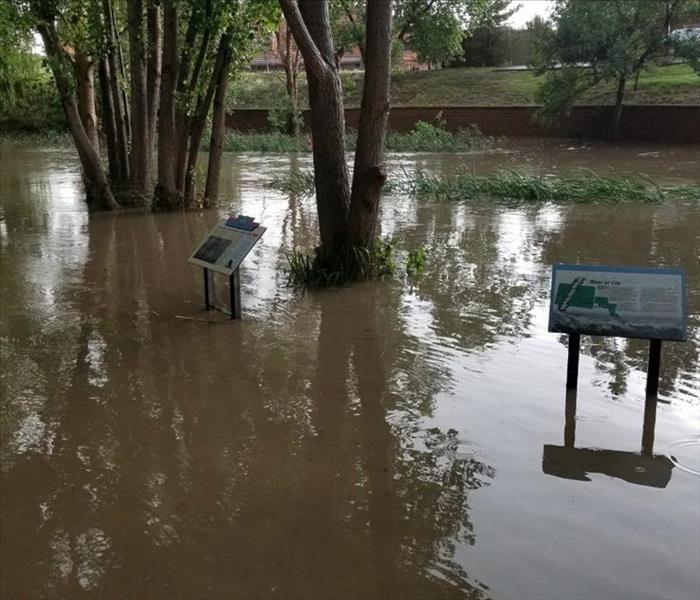
If you have standing water from a recent flood, your business is susceptible to various types of infestation. The three most common and most damaging factors that affect flooded facilities are the following:
• Insects
• Bacteria
• Mold growth
Bugs
Insects are important to the ecosystem, but you do not want a whole ecosystem growing throughout your business. Most of the peskiest bugs out there love it when your building has a flood. That's because some of them lay eggs in stagnant water and others enjoy dining on the building materials that have been softened up by moisture. Getting rid of the water as soon as possible is a priority if you want to avoid turning your facility into a swarm of insects.
Bacteria
Warm weather flooding provides a breeding ground for disease. Even if the water source is clean, it is unlikely that every object the floodwater comes into contact with is disinfected. Furthermore, organic materials start to dissolve in water very quickly, providing a solution that becomes a food source for disease-causing bacteria. A good flood recovery company will come armed with antiseptics for this reason.
Black Mold
Mold growth starts rapidly when water is present in a building. It can take as little as 24 hours for the first spores to start multiplying. This is because even in the most pristine buildings, the mold is already present. All it needs is a high level of moisture to get started multiplying and taking over the walls, ceilings and furnishings of your business. This is what makes mold one of the most common secondary sources of loss in businesses that experience flooding.
Insects, diseases and mold growth form a triad of secondary problems that can end up costing you a fortune to clean. Make sure that your water damage is taken care of correctly, and your facility is thoroughly dried, and you will minimize the risk of having issues in the future.
Commercial Building Storm Damage
3/26/2020 (Permalink)
When preparing for an upcoming spring storm, protecting your home is the priority and something you should take seriously. As a business owner, you have to do double duty because it is crucial to ensure that your business is as secure as your home.
Here are a few ways to help you avoid storm damage to your commercial property:
1. Watch, Listen, or Read
By watching the local news channel, listening to the radio throughout your commute, or reading a weather app on your phone, you will know exactly what is coming your way as well as how to prepare for it.
2. Protect the Property
Be knowledgeable about where your pipes are located. With a quick visit to the hardware store, you can gather insulation supplies for the pipes that are easy to reach. Hate the drip, drip, drip from a leaky faucet? In the event of a cold front that brings freezing weather, turning the faucet on to a drip can help you avoid a potential serious and costly pipe break. This is because the drip keeps the water moving in the pipe and does not allow it to sit and freeze. When left alone, the water can freeze and expand, and this pressure is what will break a pipe.
3. Ask for Help
Utilize others’ knowledge on how to keep your business safe. Know who you can call to help prevent damage or to fix an already broken pipe. Save the phone number of a cleanup and restoration company in your phone contacts for quick reference in case of an emergency.
No one wants to deal with the headache of storm damage or a pipe break. By being prepared and creating a plan for your business, you can ease the burden of an upcoming winter storm. Your business storm strategy can also be easily applied to your home so that you won’t have to worry if a storm hits while you’re at work.
2 Reasons to Address Mold Immediately
3/26/2020 (Permalink)

The presence of mold leaves behind an unmistakable musty odor. Although this fungus can develop inside a house when it is simply a little too humid, it is more likely to develop after floodwater damages the premises. When that flooding is accompanied by sewage loss, the contaminants only exacerbate the problem. Homeowners should try to prevent mold growth entirely. However, if mold does develop, then you need to address it right away before a bad stench turns into something much worse.
1. Structural Damage
Mold is particularly destructive to certain materials, including gypsum board, plaster and wood. Over time, these materials may weaken and change color. You may not even see the damage if the item is painted, but the paint merely hides the mildew. The only way to ensure your home remains structurally sound is to remove all presence of mold. Certain structures may need to be replaced entirely to make sure your house is safe.
2. Rapid Growth
Mold growth can get out of hand in just 24 hours. It can spread exponentially when exposed to the right conditions. Leaks, condensation and high humidity can accelerate the growth process, causing the mold to overtake entire sections of walls and flooring. Over time, this can lead to toxic black mold.
An even more dangerous aspect is that visible mold is only half the story. If you see mold, then there is a very high likelihood there is even more growing out of sight. You need someone to come out to your place immediately to ensure your house remains mold-free.
When bringing in a professional team to address mold in your home, it is vital that every sign of it is removed. This includes the mold you see on the wall as well as spores that have entered the air. Without addressing the problem comprehensively, the mold growth will simply resume, sometimes in less than a day.
Do Not Succumb to a Storm's Norm
3/12/2020 (Permalink)
Floodwaters are known for carrying mud and silt from the exterior of a home to the interior. Water removal is critical when limiting the damages to the first onslaught of storm waters. Minimizing non-salvageable materials to contaminated elements that can be demolished and discarded is challenging.
As you can see in the picture to the right, floods carried mud and silt from the exterior of this home and deposited it onto the basement floor. This before and after picture illustrates what a residency can look like after a storm’s floodwaters create water damage as well as after SERVPRO restores the property’s basement. If you have recently experienced a similar situation with water or storm damage, contact SERVPRO of College Park / Hyattsville. We will assist you in anyway to help you recover from a disaster.
While in 45 years of business, we have saved our clientele and their insurance companies from inconvenience, stress, and spending additional money. With the help of our team carefully planning an execution strategy, we always tailor our strategy towards the size of the cleanup, no matter what the damages may be, “Like it never even happened.”
Windy Weekend, Reminds Us Spring Storms Are Around the Corner
3/12/2019 (Permalink)
While temperatures continue to be on the cool side, Mother Nature reminded us that spring is around the corner. Sixty mile an hour wind gusts this last weekend was a reminder to the destructive nature of spring storms. The Joplin area suffered some minor damage. Down trees, and road signs, as well as some minor structure damage could be spotted around the area.
So, with that mind we probably need to go over our annual severe weather reminders. First, have an emergency kit ready. See our blog from last year to help build your own kit.
Spring storms carry a large amount of rain so we typically see an increase in water intrusions in the months of March through May. The destructive power of wind can also bring havoc to your home or business. We offer emergency board-up and security services if the wind leaves your structure vulnerable to the elements.
If something were to happen to your home or business please know we specialize in finding disaster recovery solutions. This goes beyond just mitigation and cleaning. We use our three decades of experience to try to be a resource to any obstacle you face in recovery. Our goal: doing what it takes to get you back to normal as soon as possible “Like it never even happened.”
Don't Let Heavy Rains Damage Home
3/12/2019 (Permalink)
Living in the Midwest our homes are under constant attack by the elements. We face extreme heat as well bitter cold. Storms that used to primarily be associated with the spring season have wreaked havoc on our homes and business year-round the last few years. These storms many times bring destructive winds, hail, and heavy rainfall. Just plain old rain can have a destructive result if your property is not properly maintained. Here are a few areas to keep your eye on as a frontline defense to water intrusion caused by rainfall.
- The ROOF. A well installed and maintained roof will keep rain from leaking into the home. That’s pretty much its job. An annual inspection looking for damage can prove invaluable. If a particularly strong or damaging storm blows through, a quick inspection might be prudent as well.
- Doors and Windows. Improperly installed or poorly sealed opening can allow water to get into the home. If you notice wet areas around these opening it should be addressed. Even a small amount of water can do damage or cause a mold problem over time.
- Gutters and Downspouts. Clogged gutters will not allow water to properly flow away from your home. Downspouts that are blocked can allow water to pool up and eventually backup into the home.
These tasks will take a little effort, but the effort will be far less than dealing with a water intrusion. If for some reason your home or business is affected by rainfall call the experts at SERVPRO.
Don't Let Storms Catch You By Surprise
3/12/2019 (Permalink)
September is National Preparedness Month. Each week a different point of preparedness is emphasized. Week one’s theme is “Make and Practice Your Plan.” Here is what they stress.
- Make an emergency plan.
- Sign up for alerts
- Establish your evacuation zone, and practice.
- Put your plan in writing or a graphic
We need to be ready for anything at any time. The weather has proved to be both unpredictable and volatile the last few years. Here in the Joplin area it seems the threat of tornadoes that used to be a concern mainly in the spring months are a concern for the majority of the year. Our crews were dispatched to Aurora Missouri just last week after a confirmed tornado touch-down.
We have also experienced unusually high rain fall amounts of the last few weeks. Localize flash flooding has been a problem in many areas.
The point? We have to be prepared at all times for just about anything. Plan ahead and I promise you will be glad you did when the moment of the unexpected happens.
Survival is obviously the main object to any disaster plans but do not overlook recovery! Let SERVPRO be a part of putting life back together in the aftermath of a storm. Are you responsible for commercial property?
Heavy Rains Can Cause A Nasty Problem
3/12/2019 (Permalink)
Too much water in the sewer can force sewer waste where you don not want it.
Heavy rains can put a lot of stress on the local drainage systems. When the sewer system reaches maximum volume waste water is forced out through floor drains, tubs, or any plumbing connected to the city sewer. Buildings with basements are particularly susceptible.
These situations are real health hazards. The water can contain solid waste and many other pathogenic hazards. It is never acceptable to enter areas affected by a sewer back up unprotected.
At Risk: With these kinds of health hazards all are considered at rick when in this environment but some are more susceptible than others. The very young, the very old, and anyone with a compromised immune system need to steer clear of these areas.
Category 3: All water damages are classified by category based on the degree of contamination. One, being the cleanest down to three, which is considered grossly contaminated. Many times, you will hear this kind of loss be referred to as “Black” water.
Personal Protection: The IICRC has a strict standard for handling a water damage such as a sewer backup because of the potential health concerns. All persons who are involved with the clean up of a sewer backup are required to wear personal protective equipment. In this case it calls for boots, gloves, protective clothing, and a full-face respirator to protect the eyes and respiratory system.
Sump Pump Failure Can Cause Substantial Damage
3/12/2019 (Permalink)
A Columbus Kansas basement underwater after the sump pumpfailed during heavy rains.
Many area homes and businesses have basements or crawl spaces. During times of rainfall sump pumps are used to keep these areas from flooding. The problem is, ownership of a sump pumpdoes not guarantee you won’t experience a flood. Like everything else associated with your home the sump pump can fail. Being in the basement or crawlspace the sump pump is many times forgotten about. Out of sight, out of mind. Overlooking normal testing of the sump pump can be a critical and expensive mistake.
- Testing the pump. Test the pump by adding a little water to the pump well. Just add enough water to lift the float mechanism to engage the pump. If it begins to pump the water out you are good to go.
- Check for blockage. After testing the pump follow the water out and away from your home. Make sure there is no blockage that would prevent water from building up and back flowing.
- Have a backup plan. Most all sump pumps work off an electrical connection through a normal wall outlet. But if the electricity to your property is knocked out do you have aback up plan? There are options available. You might want to consult your local plumber for the solution that is best for you.
Let's Get Prepared for Possible Severe Weather
3/12/2019 (Permalink)
According to the National Weather Service, We have had an active spring weather wise but fortunately we have not encountered much in the way of severe weather here in the four states. But as we all know we are no where near being out of the woods for possible sever storms. We try to help our neighbors be as prepared as possible for any disaster. Here is our annual spring sever weather reminders.
Be vigilant and aware. There a lot of ways to receive notice of the threat of sever weather these days. Weather radios (with properly charged batteries) are probably the most reliable but are sometimes impractical. Most people do not carry a weather radio around with them. Weather radios are also limited in accuracy for specific locations. The information released on weather radios cover entire counties. Cell phones are a better way to receive information of specific locations but they rely on a network of towers that can be damaged by strong storms. Television and radio are also great ways to receive updated information but they too can be interrupted by damage to their infrastructure.
Have an Emergency Kit ready. We all have been reminded many times to have a kit ready. Standard items include food and water for two days. A first aide kit, flashlight, batteries, blankets, etc. The National Weather Service, the Red Cross, and FEMA all have detailed lists you can easily find online. Just don’t procrastinate! Get a kit ready and have it accessible.
Have a rendezvous plan. Don’t assume if a disaster strikes your family will all be together and accounted for. We all have busy lives and are going in different directions. Have a plan to meet up with loved ones. Start with meeting back at your home, but if that is not possible have a back up plan to meet. Many families use a family member or other contact out of the area to coordinate the rendezvous.
As severe weather season rolls on, please be safe!
Storm Facts, Tips and Safety
10/2/2018 (Permalink)
Storm Facts, Tips and Safety
Storm FactsSevere Thunderstorm Facts
Thunderstorms are defined as storms that produce thunder and lightning. Severe thunderstorms may also produce:
- Rain
- High winds
- Sleet or snow
It’s important to note that thunderstorms do not always produce moisture. A storm in which you see lightning and hear thunder but never feel a drop of water is known as a “dry” thunderstorm. Thunderstorms that produce hail and tornadoes are known as “supercell” storms. Storms occur either in clusters or lines; therefore, they may present as a single thunderstorm or as multiple thunderstorms hitting one after the other.
Causes
Thunderstorms are caused when moisture from the lower or mid-level part of the atmosphere mixes with warm, unstable air from the ground. Moisture and air then push upwards into the higher atmosphere to form clouds that produce thunder and lightning, as well as potential precipitation. Spring, summer and fall are most conducive to thunderstorms because the sun heats the ground and moisture is more perceptible in the air, especially in humid climates.
Thunderstorms must also be lifted to begin their formation. Some sources of lift include:
- More heat on the ground than in the air
- Changes in atmospheric conditions near mountains
- Weather front changes caused by clashing cold and hot air
- Drylines, or when moist and dry air clash
- Land or sea breezes
Any of these situations can immediately create a thunderstorm without warning, even in the middle of a clear blue day. In many cases, these storms will also be accompanied by lightning. Most will not come with hail or tornadoes, unless they occur in tornado-prone states such as Kansas, Oklahoma, Texas and Missouri.
Severe Weather Facts & Myths
10/2/2018 (Permalink)
Thunder StormMyth: Highway and interstate overpasses are safe shelters against a tornado.
Fact: Overpasses can concentrate the tornado winds, causing them to be significantly stronger. This places the people under them in an even more dangerous situation. In recent years, several people seeking shelter beneath overpasses have been killed or severely injured. Being above ground level during a tornado is dangerous.
Myth: The low pressure with a tornado causes buildings to explode. Opening the windows will equalize the pressure, saving the building.
Fact: Opening the windows in an attempt to equalize pressure will have no effect. It is the violent winds and debris that cause most structural damage. It is more important for you to move to a safe area away from windows and exterior walls. With a tornado, every second counts, so use your time wisely and take cover.
Myth: Thunderstorms and tornadoes always move from west to east.
Fact: More often than not, thunderstorms move from west to east. Conditions in the atmosphere dictate how and where storms will move, and it can be in any direction. Tornadoes have been known to act erratic, and can change directions and speed very quickly. Never try to outrun a tornado in a vehicle.
Myth: It’s not raining here, and skies above me are clear, therefore I am safe from lightning.
Fact: Lightning can strike many miles away from the thunderstorm. If storms are in your area, but skies happen to be clear above you, that certainly does not imply you are safe from lightning. Though these “Bolts from the Blue” are infrequent, lightning strikes 10 to 15 miles away from the storm are not out of the question.
Myth: Since I am inside my house and out of the storm, I am completely safe from lightning.
Fact: Just because you have taken shelter inside, you are not automatically safe. While inside waiting out a storm, avoid using the telephone or electrical appliances and do not take showers or baths. Also stay away from doors and windows. Telephone lines, cords, plumbing, even metal window and door frames are all lightning conductors and pose a threat
Myth: Large and heavy vehicles, such as SUVs and pickups, are safe to drive through flood waters.
Fact: It is a common belief that the larger the vehicle, the deeper the water it can drive through. Many people do not realize that two feet of water can float most vehicles, including SUVs and pickups. If the water is moving rapidly, vehicles can be swept away.
Myth: Flash floods only occur along flowing streams.
We don't like to talk about it but it happens.
9/18/2018 (Permalink)
It's definitely not the most pleasant problem to talk about, but sewage backups or leaks are very real and very serious issues you could face in your home or business.
Earlier we discussed how to tell if the water flooding in your property is clean or contaminated It's probably the most important to know that sewage water should be assumed to be contaminated and hazardous at all times (until one of our professionals determines otherwise). Sewage water is typically referred to as category 3 black water. This classification is due to the dangerous contaminants in it. It's important to note that sewage water has the ability to appear clean. This is an instance of top water. If sewage runoff looks clean, it's usually because the waste and contaminants have sunk to the bottom. This water is still categorized as black water; not for the color, but for the risk it carries with it. In most cases of any standing water in your home, it's crucial to understand that just because you can't particularly see the contaminants or just because the water looks clear...doesn't mean that it is safe to try to mitigate yourself.
Our SERVPRO crews are specifically trained to deal with hazardous water and how to clean any harmful remnants once the water is drained. Without that training, your knowledge is your most powerful tool to keep you from putting yourself at risk upon spotting standing water in your residential or commercial property.
Let's Talk Storm Damage
8/29/2018 (Permalink)
When storm damage occurs to your home or business the restoration process can seem daunting. Not only are you faced with a frightening event most times, but as soon as the storm fades you are faced with unpleasant and unwanted damage. At SERVPRO, our goal is to make the restoration process as seamless and straightforward as possible. Our teams are equipped with the knowledge and certifications to complete the necessary restoration with as little disruption as possible.
From the moment that we receive the first call regarding storm damage to your home or business to the moment that we arrive on site to meet with the home or business owner and begin the restoration process our focus is on the customer. Our on-site professionals will explain the process and ensure that you are informed throughout the duration.
If you find yourself in need of restoration call the professionals at SERVPRO. We are always here to help and ensure that your home or business is brought back to its previous condition.
Flooding
10/5/2017 (Permalink)
Storms and heavy rains can cause heavy flooding in such a short period of time. A perfect example of this is in Lousiana currently. They had 2 feet of rain that fell consistently for 3 days, and within a 72-hour time span the streets were flooded. The National Weather Service is warning that rivers will stay in flood stage for days
Flooding means that not only will a homeowner have to think about the current situation of being displaced from their home and losing some of their personal belongings, but the results after the water is gone. Standing water is a breeding ground for bacteria.
Once the water has subsisded the presence of dirt, grime, bacteria and mold will be present. The level of these things depends on how long the standing water is left unattended. In a case like Louisiana there is no telling when the water can be extracted from the towns let alone peoples houses.
After the waters have subsided and before you immediately enter your home refer to this checklist.
1. Watch out for wild animals, poisonous snakes that may have entered the home, check thru the debris.
2. Watch out for plaster, loose ceiling structures and document everything for yourself and for insurance purposes.
3. Throw away any food, anything that may have come in contact with the flood waters, anything in the fridge.
4. Check electrical systems, gas leaks, sewage and water lines all for damage.
Evacuation Plan
10/3/2017 (Permalink)
Water (one gallon per person per day)
· Food (non-perishable 3-day supply)
· Manual can opener
· Battery operated radio, preferably a NOAA Weather Radio
· Flashlight and extra batteries
· First aid kit
· Whistle to signal for help
· Clothing
· Dust masks or bandanas
· Plastic sheeting, garbage bags and duct tape
· Wrench or pliers to turn off utilities
· Hygiene items
· Important documents; copies of insurance policies, identification and bank account information
· Cash
· Fire extinguisher
· Matches in a waterproof container
SERVPRO of College Park / Hyattsville is locally owned and operated—so we’re a part of this community too. We are also part of a national network of over 1,700 Franchises, which enables us to respond quicker with more resources. For major storms and disasters, we can call upon special Disaster Recovery Teams strategically located throughout the country.
Hurricane Preparedness Week is Almost Here...
5/13/2016 (Permalink)
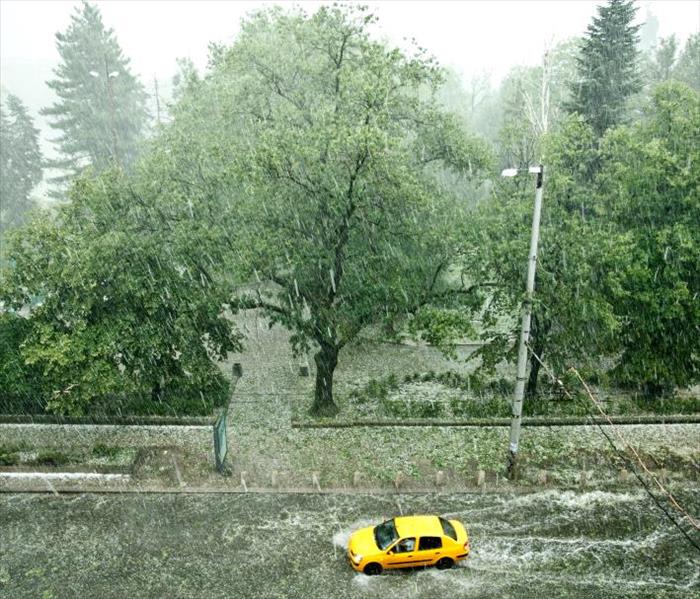 Look familiar?
Look familiar?
Hurricane Preparedness:
Summer is approaching and that means another hurricane season is soon to begin. While June 1st marks the official start of hurricane season, May is a month for hurricane awareness and preparation. The National Hurricane Center states,
“A lack of hurricane awareness and preparation are common threads among all major hurricane disasters. By knowing your vulnerability and what actions you should take, you can reduce the effects of a hurricane disaster.”
This year National Hurricane Preparedness Week will be held May 15th through May 21st. The goal of Hurricane Preparedness Week is to help educate citizens by providing information about hurricane hazards and preparation, to help protect the public and their families. The more you know about preparing yourself the better you will be able to handle a disaster.
Go to: http://www.nws.noaa.gov/com/weatherreadynation/hurricane_preparedness.html for more information.



 24/7 Emergency Service
24/7 Emergency Service









